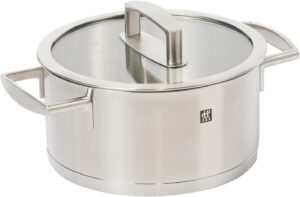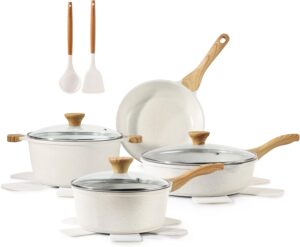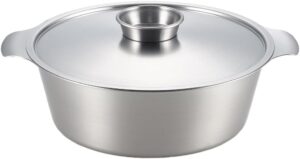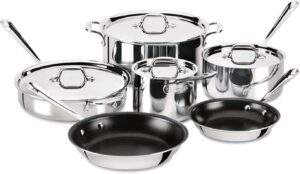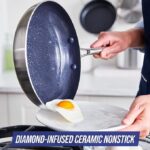Which Country Makes the Best Cookware?
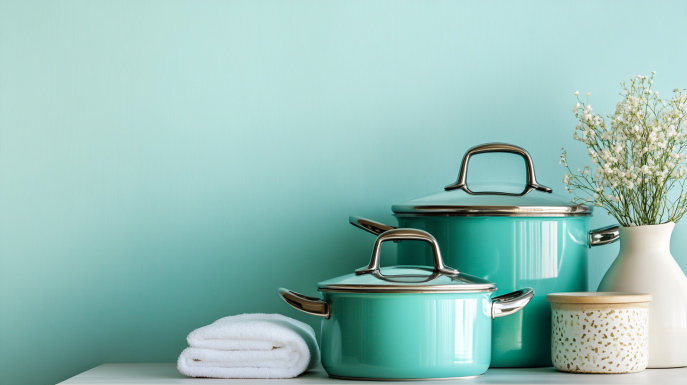
Some of them rely on the quality and durability, outstanding performance, from trusted brands. Many countries worldwide have made a good name through the making of great cookware items; from high-end stainless steel to greatly crafted cast iron. But where exactly would one get the best cookware brands? The following guide will point out the top countries associated with culinary craftsmanship and find out what makes their cookware brands stand out for the chefs and home cooks of the world.
Top Countries Known for the Best Cookware Manufacturing
Among the countries that make high-quality cookware, craftsmanship, innovation, and dedication to quality are outstanding. Following are the top countries that are known to create some of the best cookware in the world:
1. Germany
The reputation for precision engineering has made Germany a home for well-recognized brands like Zwilling and WMF. From practically indestructible stainless steel to ever-improving non-stick technologies, German cookware is known for durability and functionality. Innovation within the country secures its place in providing top-tier performance in professional settings and home kitchens alike.
2. France
With its gastronomic past, France is the birthplace of some iconic cookware brands like Le Creuset and Mauviel. French manufacturers are often famous for their superior enameled cast iron, copper, and stainless steel cookware. They often merge traditional skills with modern technology.
3. United States
The US is not far behind in cast iron cookware, either, with Lodge leading the charge. American cookware manufacturers are renowned for coming up with really sturdy but cheap cookware serving well for very heavy-duty use. Other brands, like All-Clad, represent high-performance options in stainless steel made from advanced craftsmanship.
4. Italy
Italy merges aesthetics with functionality in its cookware to provide beautiful cookware for functionality. Major brands, such as Ballarini and Lagostina, boast stunning designs and great craftsmanship in stainless steel and non-stick cookware. Italian cookware often combines traditional techniques with modern innovations.
5. Japan
As a case in point, take some Japanese brands, like Yoshikawa and Tamagawa, and their notorious attention to every detail regarding cookware made of stainless steel and carbon steel. Japanese manufacturers often focus on producing lightweight, durable cookware for precise cooking, incorporating advanced technology.
6. Switzerland
The Swiss commitment to precision engineering is also poured into their cookware, with brands like Swiss Diamond gaining international acclaim. Their manufacturers are known for high-quality, non-stick cookware and inventive designs that improve cooking efficiency and ease.
Each of these countries contributes its unique strengths and signature products to the cookware industry, one more reason for their leading positions in the global market when it comes to cookware excellence.
What Makes German Cookware Stand Out?
German cookware is exemplary for many reasons, reflecting the commitment of the nation to quality, precision, and innovativeness. Some of these are as follows:
1. Precision Engineering
Generally speaking, German cookware is one of the best engineering available in the world. With advanced technology in manufacturing and also strict quality control, brands such as Zwilling and WMF make sure that every single unit is high in performance and strength.
2. Durability and Strength
German kitchen utensils have been developed to bear the strongest stresses in the professional kitchens and in households. Made from superior raw materials, including stainless steel and grey cast iron, these items boast of durability, frictional resistance, and their service endurance.
Also read: Precision Cooking with the Best Sous Vide Machines in 2024
3. Innovative Technology
German manufacturers are among the most avant-garde with regard to cookware technologies. They inlay high-end features advanced in evenly distributed heat, ergonomic handles, and high-quality non-stick coatings. Innovations such as WMF’s TransTherm base provide even heat distribution and energy efficiency.
4. Quality Materials
German cookware is mainly manufactured with very high-quality raw materials, including high-quality stainless steel with a high content of chromium and nickel, further enhancing its resistance to corrosion, thus giving it a longer life. Quality materials assure cooks of better cooking performance and durability.
5. Design and Functionality
German cookware fuses functionality with art: design practically offers ease, such as easy-to-clean surfaces and ergonomic handles, and is aesthetically pleasing all at once. Both professionals and amateurs adore this combination of form and function.
6. Reputation for Excellence
German brands have, over the years, established their reputation for ensuring that cookware is durable and high-performance. Consistency in product quality and consumer satisfaction further cements trust in German-made cookware.
In a nutshell, precision engineering, durable materials, advanced technology, and well-thought-out design make German cookware among the most opted-for by whoever respects high-quality cooking utensils.
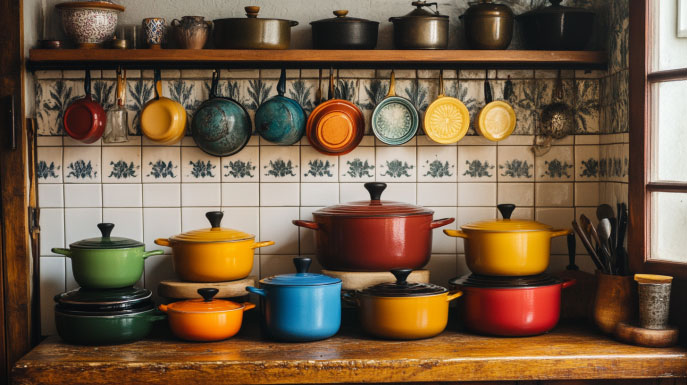
The Legacy of French Cookware: Why It’s a Global Favorite
French cookware inherited its reputation in a number of ways: through the rich legacy of craftsmanship, tradition, and innovation passed down through the generations. Here’s why French cookware remains a favorite globally:
1. Centuries-Old Craftsmanship
French cookware boasts several centuries of food preparation heritage and experience. Le Creuset and Mauviel are just some of the brands to have mastered their line of work for many years, skillfully marrying artisanal flair with modern innovations to produce cookware that is as aesthetically beautiful as it is useful.
2. Exceptional Materials
French cookware has become famous because of the use of quality materials-enamelled cast iron, copper, and stainless steel. Each material was chosen for its properties that enhance the cooking process. For instance, Le Creuset’s cast iron retains heat particularly well, and the copper used in Mauviel cookware makes for very accurate temperature regulation.
3. Innovative Design
This is where French manufacturers have made important contributions to the modern cookware industry: innovative design. Most French cookware includes ergonomic handles, versatile shapes, and aesthetically pleasing finishes that further enhance the cooking experience and presentation of the dishes.
4. Versatility and Performance
The French cookware is so practical and efficient. From the classical French oven to the sophisticated copper skillet, the pieces from France are engineered to excel in several manners of cooking. This consistency and quality of results have made them indispensable in professional kitchens and home kitchens alike.
5. Tradition in Cuisine
In the culinary tradition of France, technique and flavor are equally important. With this in mind, French cookware will support the said tradition by allowing chefs to execute classic techniques with precision. The capability that it possesses, with regard to supporting complex dishes from light sauces down to rich stews, shows how it furthers gastronomic excellence.
We also recommend you to read ‘A Quick Review of the CAROTE Pots and Pans Set, a must-have in 2024‘
6. Aesthetic Appeal
French cookware is as much about the art of aesthetics as it is about functionality. Elegant design, bright colors, and classic shapes make every kitchen a bit more sophisticated with just that touch of class. A blend of form and function, French cookware turns out to be a practical choice but at the same time very stylish.
7. Global Influence
French cuisine influences many a cuisine worldwide, and so does its cookware. The continued popularity of French techniques and dishes helped gain French cookware great recognition internationally, gaining the first choice for chefs and home cooks alike the world over.
French cookware heritage is situated at the nexus of historical craftsmanship, quality materials, innovative design, and deep connections to tradition within the culinary arts. This mix of attributes certainly ensures that among the cookery knick-knacks, French cookware has a coveted position in the quest for excellence.
Comparing American and European Cookware Brands: What’s the Difference?
Differences between America and Europe in cookware brands reflect distinct approaches to craftsmanship, design, and functionality that come into sharp focus.
American cookware brands are often mentioned as being durable and practical. For instance, Lodge and All-Clad have good reputations for their construction and performance, with Lodge specialized in cast iron cookware and All-Clad in high-quality stainless steel cookware. Cookware made in America usually offers various prepared lineups for heavy use, from professional chefs to home cooks who need something more reliable and long-lasting. Often, the design will lean more to function rather than fashion, even though some of the brands, like All-Clad, encompass sophisticated features and sleek designs.
Conversely, European cookware often merges traditional craftsmanship with technologically advanced production. European cookware is a top-of-the-range product; much artisanal quality and a strong sense of heritage and design are central to the manufacture of European cookware. Le Creuset is famous for its enameled cast iron; durability combined with vibrant finishes in elegant hues. Mauviel, a well-known French manufacturer of copper cookware, boasts precision in temperature regulation and unparalleled heat conductivity. Much European cookware promotes the beauty of appearance with the function and thus develops designs that strike the eye yet remain highly functional.
Other differences are in the materials used. American brands commonly use stainless steel, cast iron, and non-stick coatings. Europeans turn to copper, which allows better thermal conductivity, and enameled cast iron makes them look nice and retains the heat well.
While American and European cookware brands both make excellent cookware, American cookware focuses on durability and functionality, while in Europe, the companies pride themselves on artisan craftsmanship and design beauty. This difference in brand orientation is naturally an outgrowth of different priorities and preferences that shape the cookware industries in these regions.

